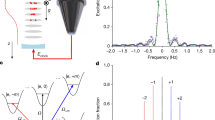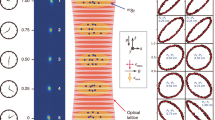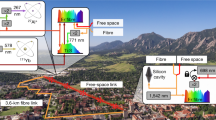Abstract
Rapid progress in optical atomic clock performance has advanced the frontiers of timekeeping, metrology and quantum science1,2,3. Despite considerable efforts, the instabilities of most optical clocks remain limited by the local oscillator rather than the atoms themselves4,5. Here we implement a ‘multiplexed’ one-dimensional optical lattice clock, in which spatially resolved strontium atom ensembles are trapped in the same optical lattice, interrogated simultaneously by a shared clock laser and read-out in parallel. In synchronous Ramsey interrogations of ensemble pairs we observe atom–atom coherence times of 26 s, a 270-fold improvement over the measured atom–laser coherence time, demonstrate a relative instability of \(9.7(4)\times {10}^{-18}/\sqrt{\tau }\) (where τ is the averaging time) and reach a relative statistical uncertainty of 8.9 × 10−20 after 3.3 h of averaging. These results demonstrate that applications involving optical clock comparisons need not be limited by the instability of the local oscillator. We further realize a miniaturized clock network consisting of 6 atomic ensembles and 15 simultaneous pairwise comparisons with relative instabilities below \(3\times {10}^{-17}/\sqrt{\tau }\), and prepare spatially resolved, heterogeneous ensemble pairs of all four stable strontium isotopes. These results pave the way for multiplexed precision isotope shift measurements, spatially resolved characterization of limiting clock systematics, the development of clock-based gravitational wave and dark matter detectors6,7,8,9,10,11,12 and new tests of relativity in the lab13,14,15,16.
This is a preview of subscription content, access via your institution
Access options
Access Nature and 54 other Nature Portfolio journals
Get Nature+, our best-value online-access subscription
$29.99 / 30 days
cancel any time
Subscribe to this journal
Receive 51 print issues and online access
$199.00 per year
only $3.90 per issue
Buy this article
- Purchase on Springer Link
- Instant access to full article PDF
Prices may be subject to local taxes which are calculated during checkout




Similar content being viewed by others
Data availability
The experimental data presented in this manuscript are available from the corresponding author upon reasonable request. Source data are provided with this paper.
Code availability
The code used for experimental control, data analysis and simulation in this work are available from the corresponding author upon reasonable request.
References
Ludlow, A. D., Boyd, M. M., Ye, J., Peik, E. & Schmidt, P. O. Optical atomic clocks. Rev. Mod. Phys. 87, 637–701 (2015).
Campbell, S. L. et al. A Fermi-degenerate three-dimensional optical lattice clock. Science 358, 90–94 (2017).
McGrew, W. F. et al. Atomic clock performance enabling geodesy below the centimetre level. Nature 564, 87–90 (2018).
Schioppo, M. et al. Ultrastable optical clock with two cold-atom ensembles. Nat. Photon. 11, 48–52 (2017).
Oelker, E. et al. Demonstration of 4.8 × 10−17 stability at 1 s for two independent optical clocks. Nat. Photon. 13, 714–719 (2019).
Safronova, M. S. et al. Search for new physics with atoms and molecules. Rev. Mod. Phys. 90, 025008 (2018).
Kolkowitz, S. et al. Gravitational wave detection with optical lattice atomic clocks. Phys. Rev. D 94, 124043 (2016).
Stadnik, Y. V. & Flambaum, V. V. Improved limits on interactions of low-mass spin-0 dark matter from atomic clock. spectroscopy. Phys. Rev. A 94, 022111 (2016).
Derevianko, A. & Pospelov, M. Hunting for topological dark matter with atomic clocks. Nat. Phys. 10, 933–936 (2014).
Arvanitaki, A., Huang, J. W. & Van Tilburg, K. Searching for dilaton dark matter with atomic clocks. Phys. Rev. D 91, 015015 (2015).
Wcisło, P. et al. New bounds on dark matter coupling from a global network of optical atomic clocks. Sci. Adv. 4, eaau4869 (2018).
Kennedy, C. J. et al. Precision metrology meets cosmology: improved constraints on ultralight dark matter from atom-cavity frequency comparisons. Phys. Rev. Lett. 125, 201302 (2020).
Chou, C. W., Hume, D. B., Rosenband, T. & Wineland, D. J. Optical clocks and relativity. Science 329, 1630–1633 (2010).
Takano, T. et al. Geopotential measurements with synchronously linked optical lattice clocks. Nat. Photon. 10, 662–666 (2016).
Grotti, J. et al. Geodesy and metrology with a transportable optical clock. Nat. Phys. 14, 437–441 (2018).
Takamoto, M. et al. Test of general relativity by a pair of transportable optical lattice clocks. Nat. Photon. 14, 411–415 (2020).
Hinkley, N. et al. An atomic clock with 10−18 instability. Science 341, 1215–1218 (2013).
Bloom, B. J. et al. An optical lattice clock with accuracy and stability at the 10−18 level. Nature 506, 71–75 (2014).
Marti, G. E. et al. Imaging optical frequencies with 100 μHz precision and 1.1 μm resolution. Phys. Rev. Lett. 120, 103201 (2018).
Bothwell, T. et al. JILA SrI optical lattice clock with uncertainty of 2.0 × 10−18. Metrologia 56, 065004 (2019).
Boulder Atomic Clock Optical Network (BACON) Collaboration. Frequency ratio measurements at 18-digit accuracy using an optical clock network. Nature 591, 564–569 (2021).
Itano, W. M. et al. Quantum projection noise: population fluctuations in two-level systems. Phys. Rev. A 47, 3554 (1993).
Dick, G. J., Prestage, J. D., Greenhall, C. A. & Maleki, L. Local oscillator induced degradation of medium-term stability in passive atomic frequency standards. In Proc. 22nd Precise Time and Time Interval Meeting (Ed.Sydnor, R. L.) 487–508 (NASA, 1990).
Kim, M. E. et al. Optical coherence between atomic species at the second scale: improved clock comparisons via differential spectroscopy. Preprint at https://arxiv.org/abs/2109.09540 (2021).
Nicholson, T. L. et al. Comparison of two independent Sr optical clocks with 1 × 10−17 stability at 103 s. Phys. Rev. Lett. 109, 230801 (2012).
Clements, E. R. et al. Lifetime-limited interrogation of two independent 27Al+ clocks using correlation spectroscopy. Phys. Rev. Lett. 125, 243602 (2020).
Young, A. W. et al. Half-minute-scale atomic coherence and high relative stability in a tweezer clock. Nature 588, 408–413 (2020).
Matei, D. G. et al. 1.5 μm lasers with sub-10 mHz linewidth. Phys. Rev. Lett. 118, 263202 (2017).
Swallows, M. D. et al. Suppression of collisional shifts in a strongly interacting lattice clock. Science 331, 1043–1046 (2011).
Martin, M. J. et al. A quantum many-body spin system in an optical lattice clock. Science 341, 632–636 (2013).
Blatt, S. et al. Rabi spectroscopy and excitation inhomogeneity in a one-dimensional optical lattice clock. Phys. Rev. A 80, 052703 (2009).
Hutson, R. B. et al. Engineering quantum states of matter for atomic clocks in shallow optical lattices. Phys. Rev. Lett. 123, 123401 (2019).
Pedrozo-Peñafiel, E. et al. Entanglement on an optical atomic-clock transition. Nature 588, 414–418 (2020).
Beloy, K. et al. Faraday-shielded dc stark-shift-free optical lattice clock. Phys. Rev. Lett. 120, 183201 (2018).
Zhang, W. et al. Ultrastable silicon cavity in a continuously operating closed-cycle cryostat at 4 K. Phys. Rev. Lett. 119, 243601 (2017).
Milner, W. R. et al. Demonstration of a timescale based on a stable optical carrier. Phys. Rev. Lett. 123, 173201 (2019).
Norcia, M. A. et al. Seconds-scale coherence on an optical clock transition in a tweezer array. Science 366, 93–97 (2019).
Dörscher, S. et al. Lattice-induced photon scattering in an optical lattice clock. Phys. Rev. A 97, 063419 (2018).
Boyd, M. M. et al. Nuclear spin effects in optical lattice clocks. Phys. Rev. A 76, 022510 (2007).
Delaunay, C., Ozeri, R., Perez, G. & Soreq, Y. Probing atomic Higgs-like forces at the precision frontier. Phys. Rev. D 96, 093001 (2017).
Berengut, J. C. et al. Probing new long-range interactions by isotope shift spectroscopy. Phys. Rev. Lett. 120, 091801 (2018).
Takano, T., Mizushima, R. & Katori, H. Precise determination of the isotope shift of 88Sr – 87Sr optical lattice clock by sharing perturbations. Appl. Phys. Express 10, 072801 (2017).
Miyake, H., Pisenti, N. C., Elgee, P. K., Sitaram, A. & Campbell, G. K. Isotope-shift spectroscopy of the 1S0 → 3P1 and 1S0 → 3P0 transitions in strontium. Phys. Rev. Res. 1, 033113 (2019).
Counts, I. & Hur, J. et al. Evidence for nonlinear isotope shift in Yb+ search for new boson. Phys. Rev. Lett. 125, 123002 (2020).
Taichenachev, A. V. et al. Magnetic field-induced spectroscopy of forbidden optical transitions with application to lattice-based optical atomic clocks. Phys. Rev. Lett. 96, 083001 (2006).
Madjarov, I. S. et al. An atomic-array optical clock with single-atom readout. Phys. Rev. X 9, 041052 (2019).
Gil, L. I. R., Mukherjee, R., Bridge, E. M., Jones, M. P. A. & Pohl, T. Spin squeezing in a Rydberg lattice clock. Phys. Rev. Lett. 112, 103601 (2014).
Van Damme, J., Zheng, X., Saffman, M., Vavilov, M. G. & Kolkowitz, S. Impacts of random filling on spin squeezing via Rydberg dressing in optical clocks. Phys. Rev. A 103, 023106 (2021).
Bothwell, T. et al. Resolving the gravitational redshift within a millimeter atomic sample. Nature https://doi.org/10.1038/s41586-021-04349-7 (2022).
Lemonde, P. & Wolf, P. Optical lattice clock with atoms confined in a shallow trap. Phys. Rev. A 72, 033409 (2005).
Campbell, G. K. et al. The absolute frequency of the 87Sr optical clock transition. Metrologia 45, 539 (2008).
Schmid, S., Thalhammer, G., Winkler, K., Lang, F. & Denschlag, J. H. Long distance transport of ultracold atoms using a 1D optical lattice. New J. Phys. 8, 159 (2006).
Ma, L. S., Jungner, P., Ye, J. & Hall, J. L. Delivering the same optical frequency at two places: accurate cancellation of phase noise introduced by an optical fiber or other time-varying path. Opt. Lett. 19, 1777–1779 (1994).
Falke, S., Misera, M., Sterr, U. & Lisdat, C. Delivering pulsed and phase stable light to atoms of an optical clock. Appl. Phys. B 107, 301–311 (2012).
Swallows, M. D. et al. Operating a 87Sr optical lattice clock with high precision and at high density. IEEE Trans. Ultrason. Ferroelectr. Freq. Control. 59, 416–425 (2012).
Acknowledgements
We thank J. Ye, A. Kaufman, J. Thompson, T. Bothwell and A. Jayich for insightful discussions and helpful feedback on the manuscript. This work was supported in part by the NIST Precision Measurement Grants program, the Northwestern University Center for Fundamental Physics and the John Templeton Foundation through a Fundamental Physics grant, the Wisconsin Alumni Research Foundation, the Army Research Office through agreement number W911NF-21-1-0012 and a Packard Fellowship for Science and Engineering.
Author information
Authors and Affiliations
Contributions
X.Z. designed and built the experimental apparatus with assistance from J.D., V.L., H.L. and B.N.M., and with guidance from S.K. All authors contributed to maintenance and operation of the experimental apparatus, data collection, data analysis and writing of the manuscript.
Corresponding author
Ethics declarations
Competing interests
The authors declare no competing interests.
Peer review
Peer review information
Nature thanks the anonymous reviewers who contributed to the peer review of this paper. Peer reviewer reports are available.
Additional information
Publisher’s note Springer Nature remains neutral with regard to jurisdictional claims in published maps and institutional affiliations.
Extended data figures and tables
Extended Data Fig. 1 Lattice and clock path.
Schematic diagram showing the lattice and clock beam paths for the interrogation the \(|{}^{1}{S}_{0},{m}_{F}=\pm 5/2\rangle \leftrightarrow |{}^{3}{P}_{0},{m}_{F}=\pm 3/2\rangle \sigma \)-transition. To interrogate the \(|{}^{1}{S}_{0},{m}_{F}=\pm 9/2\rangle \leftrightarrow |{}^{3}{P}_{0},{m}_{F}=\pm 9/2\rangle \)-transition, the first order diffraction clock beam is overlapped with the lattice by first using a long-pass dichroic beam splitter and subsequently transmitting through the polarized beam splitter, shown in the dashed blue box. The inset shows the corresponding orientations of the bias magnetic field (B) and the lattice and clock polarizations (ε). Abbreviations: PBS, polarized beam-splitter; DBS, dichroic beam-splitter; AOM, acousto-optic-modulator; PD, photo-diode; HWP, half-waveplate; QWP, quarter-waveplate.
Extended Data Fig. 2 Energy levels diagram.
a, Energy level diagram for strontium. The double-arrow lines correspond to the relevant transitions, including the 461-nm 1S0 ↔ 1P1 transition for the first-stage MOT and imaging, the 689-nm 1S0 ↔ 3P1 transition for narrow-linewidth MOT, spin-polarization and in-lattice-cooling, the 679-nm 3P0 ↔ 3S1 and 707-nm 3P2 ↔ 3S1 transitions for repumping, and the 698-nm 1S0 ↔ 3P0 transition for clock interrogation. The wavy lines correspond to spontaneous emission. b, Hyperfine clock states. Red double arrows represent clock interrogation of the \(|{}^{1}{S}_{0},{m}_{F}=\pm 9/2\rangle \leftrightarrow |{}^{3}{P}_{0},{m}_{F}=\pm 9/2\rangle \) transition. Blue double arrows represent clock interrogation of the \(|{}^{1}{S}_{0},{m}_{F}=\pm 5/2\rangle \leftrightarrow |{}^{3}{P}_{0},{m}_{F}=\pm 3/2\rangle \) transition. Grey dashed lines stand for transitions for coherent transfer of atoms from \(|{}^{1}{S}_{0},{m}_{F}=\pm 9/2\rangle \) states to \(|{}^{3}{P}_{0},{m}_{F}=\pm 3/2\rangle \) states.
Extended Data Fig. 3 Timing diagram.
a, Typical timing diagram for a Ramsey spectroscopy sequence, in which laser cooling, state preparation and camera imaging contribute to about 1.6 s dead time, with clock interrogation time ranging from 10 ms to 20 s. b, c, The corresponding lattice retro detuning, lattice velocity and lattice acceleration for loading two ensembles at 1 cm separation.
Extended Data Fig. 4 Comparison of bias correction.
a, b, Comparison of ‘closed-loop’ analysis with (a) and without (b) bias correction. 197 unique ‘closed-loop’ combinations are shown, with each datum corresponds to the sum frequency within each loop. Shaded area represents a window of 1 × 10−18.
Extended Data Fig. 5 Differential density shift.
a, Measured differential density shift as a function of atom number difference between two symmetrically prepared ensembles at 1 cm separation. The data is taken at 20 Erec lattice trap depth with 6 s interrogation time. Dashed line is the linear fitting, in which the slope is extracted as −8.5(6) × 10−19 shift per 100 atom number difference. b, Scaling of differential density shift per 100 atom number difference between ensemble pairs with lattice trap depth U. The dashed line is a fit to the expected αU5/4 + β scaling20, where α and β are fit parameters.
Supplementary information
Supplementary Information
This file contains Supplementary Information, including Supplementary Figs. 1–8 and additional references.
Rights and permissions
About this article
Cite this article
Zheng, X., Dolde, J., Lochab, V. et al. Differential clock comparisons with a multiplexed optical lattice clock. Nature 602, 425–430 (2022). https://doi.org/10.1038/s41586-021-04344-y
Received:
Accepted:
Published:
Issue Date:
DOI: https://doi.org/10.1038/s41586-021-04344-y
This article is cited by
-
Direct comparison of two spin-squeezed optical clock ensembles at the 10−17 level
Nature Physics (2024)
-
Affordable medium-finesse optical cavity for diode laser stabilization
Applied Physics B (2024)
-
Realizing spin squeezing with Rydberg interactions in an optical clock
Nature (2023)
-
A lab-based test of the gravitational redshift with a miniature clock network
Nature Communications (2023)
-
Quantum networks with neutral atom processing nodes
npj Quantum Information (2023)
Comments
By submitting a comment you agree to abide by our Terms and Community Guidelines. If you find something abusive or that does not comply with our terms or guidelines please flag it as inappropriate.



